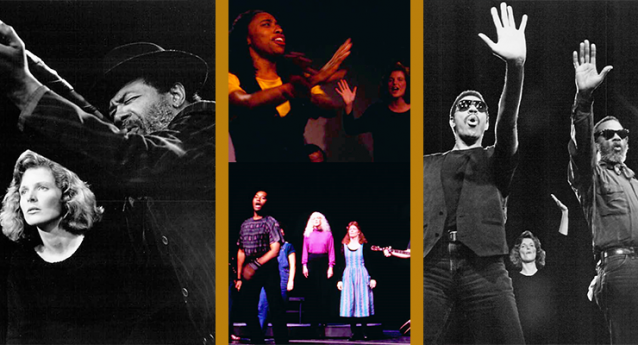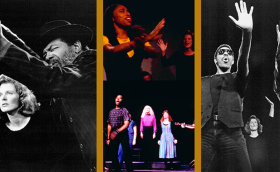Where do we stand on issues of race and class in the present historical moment, and what role can theater play in the ongoing freedom struggle?
The October 50th Anniversary Celebration of the founding of the Free Southern Theater (FST) brought activists and artists of different ages and backgrounds together with civil rights veterans, who as young men and women in the 1960s put their lives on the line for freedom. Often described as the theater wing of the civil rights movement, the Free Southern Theater was founded in 1963 at Tougaloo College in Mississippi by Student Nonviolent Coordinating Committee (SNCC) members Doris Derby, Gilbert Moses, and John O’Neal. In 1985, O’Neal held a funeral, “a valediction without mourning,” in New Orleans for the Free Southern Theater. People came from struggling communities across the US to act and think together about social justice and to witness theater’s power to advance human rights. Roadside performed South of the Mountain, which tells the story of the moment in a family when hillside farming and barter gave way to coalmining and the company store. The 1985 funeral’s week-long series of performances and dialogues culminated in a traditional second line. Snaking out of Congo Square down Dumaine Street into Treme, the relic-filled FST coffin, its pallbearers, and its gathering of followers shimmied and shook to the syncopated beat of a traditional brass marching band.
From the ashes of the FST arose Junebug Productions and its ongoing collaboration with Roadside Theater (the theater wing of Appalshop), and Austin, Texas - based producers, Holden & Arts Associates. In the ensuing 28 years, the three-way partnership created new plays and developed innovative ways to engage with community organizations across 49 states. To host any Junebug – Roadside performance and workshop, the local presenter had to commit to engaging the full diversity of people in their community.
With our partnership’s goal of building people power, who was in the audience became a central concern. We were swimming upstream against a strong current: For the past 30 years, surveys have consistently found that the nonprofit professional theater draws 80% of its audience from the wealthiest 15% of the people. This is not to point a finger at those who attend, but to ask, what would it take to make room for the rest of us?
To guide our efforts, we developed a Matrix of Principles for the creation and presentation of our work. Our plays would uncover and explore the stories suppressed by master narratives, and we would enact them in open theatrical forms that encouraged audience call and response. Our approach to touring would be framed by a respect for the inherent genius of every cultural community that presented us, and by the understanding that those with a problem (for example, poverty) had to be the generative voice for creating a solution.
Here’s one story about our work together to engage a diverse audience:
Hearing in 1989-90 from community members that racism was on the rise, Junebug, Roadside, and Holden Arts decided to create and tour a musical play about the historical relationship between black and white poor and working class people in the South. The play would span the time from the slave trade and the first landing of indentured servants through the Vietnam War. To build a foundation for the play, we sat in story circles to listen to each other and to better hear ourselves. The circles helped us talk more frankly about race and class, and, as we began to understand our differences, we were better able to see our history and present circumstances. After arriving at a production we felt was real and testing it and revising it with our home audiences in New Orleans and Whitesburg, we set about touring, our stock in trade.
As we began to travel across the South, the trick became how to get black and white working class and poor people to attend. In the main, such folks don't hang out together, much less go to professional theater. We knew if we didn’t get such folks in the house - no matter how popular the drama might be with others (and it was) - that we had failed.
After exhausting our stock of promotional strategies, including getting the word out to places like barbershops and bars where politics are discussed and producing our own radio spots with welcoming racial and class signifiers, we hit on an idea: Every community wishing to present Junebug/Jack would have to agree to form an ecumenical community choir to perform in the show. Reflecting each community’s diversity, this new choir might include singers from the black churches, choir members from the white churches, singers from the women's chorus, maybe others from the high school glee club. Several months before we arrived, each newly formed community chorus received the show’s music and designated a chorus master to conduct evening rehearsals. A few days before the opening performance, as the director, I staged the chorus into the show.
A lot of things happened in the course of this process. For starters, the play’s presenter had to begin thinking about the whole community while pulling the chorus together. The singers didn’t volunteer to discuss race and class -- they came together because they loved to sing, and this professional play looked like a good opportunity to shine. In the course of rehearsing the music, they naturally hit on a sound that had never been heard in the community, simply because all those different talents had never been joined before -- and certainly not to sing beautifully crafted, down to earth songs about the cruelty, heartache, and paradoxes of 400 years of race and class struggle. In this way, Junebug/Jack would swell from a professional cast of six to twenty or more. And I can assure you that the community’s participation only raised the artistic quality of the production -- how much local talent goes unappreciated for lack of a meaningful book and finely crafted musical score!
When the show opened, a cross-section of the entire community was present. It didn’t hurt that all the churches had to come out in support of their people. Because the performances enabled everyone to feel confident about their own traditions, cultural chips fell off shoulders. All became eager to witness and to learn more about the other traditions: to experience how the black people sang, or how the white people sang, or what inflections young people brought to the song.
Performing in New Orleans in 1997 to launch a state-wide tour, the ecumenical community choir was thirty-two strong. What a magnificent procession they made swaying down the church aisle in a converted bowling alley singing This Little Light of Mine. At the conclusion of the performance, the church’s powerful preacher asked the five hundred audience members to bow their heads as she led a prayer for our safe keeping. This was encouraging because earlier that week Klan leader David Duke had been stirring things up in the communities we were about to visit.
In the days after these community performances, audience members were invited to join story circles to tell about the dynamics of race and class in their community. With a new-found permission based on trust, they told each other stories that were typically complex, hard, and emotional – and untold before in “mixed” company. In Junebug/Jack, the catharsis didn't occur on the stage but in the community.
So how do we move toward a theater of liberation?
Many people, including younger people, now want to learn about the role of art in the struggle for justice. Stephanie McKee is Junebug’s new artistic director. She comes to the job with a background of growing up in New Orleans as an artist and working as a community organizer. Appalshop’s new 26-year-old institutional development director, Ada Smith, was raised in the Appalachian coalfields, and shares a similar arts and social justice background. Both represent the hope many of us have for new leadership in the inevitable struggle ahead.
One of our present challenges is inadequate access to the practice and theory of social justice-minded artists working in the last century and before. How do people learn from the work of rural grassroots theater in New York State from 1918 – 1960? What inspiration lies undiscovered in the 40 years of touring beginning in 1900 to thousands of Hispanic communities across the U.S. by Virginia Fabregas, her company, and a full orchestra? What example is there in the New York City African Company, formalized in 1821, producing Shakespeare’s Macbeth and The Drama of King Shotaway, which called for a U.S. slave rebellion? (New York City authorities closed the African Company’s theater in 1823 declaring it a public nuisance.) These three examples among countless that could be cited raise the question:
What would a strategy to reclaim the democratic heritage of the American theater look like?
The FST 50th reminded us that a new populist movement like that represented by the civil rights movement will have to span race and class in an authentic grassroots way, and draw on the strengths of both classical conservative and liberal political philosophy. Any nascent popular movement will have to dodge being co-opted by either neo-conservatives or neo-liberals, by the hard right or the hard left. It will depend on a renewed sense of solidarity forming across the lines that presently divide.
SNCC activists used to say, “When people don’t have anything to do, they do each other.” As we reel from 30 years of unrelenting anti-democratic pressure to silence all but the messages of powerful elites, there’s been a lot of doing each other in the nonprofit arts sector, in our social justice field, and in our networks and organizations. We’ve painted ourselves into many separate corners, and it will be messy getting out of them. But that’s what we need to do, and what can help us is the rekindling of critical discourse. First among ourselves, we need to face unresolved issues and animosities and settle them based on principles we agree to share. In 1960, the enemy, Jim Crow, was known. To effectively move forward, we must come to understand who the enemy is now. I think we can only understand that collectively, through an intentional, iterative process of building and sharpening each other.
What would a critical discourse to build a theater of liberation look like?
_______
Dudley Cocke is the artistic director of Roadside - [email protected]

